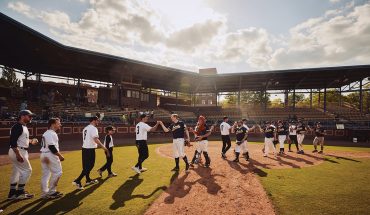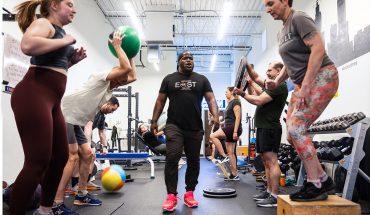by J. Michael Welton
photographs by Geoff Wood
It’s early August, and Cam Ingram, 38, is under the gun, busily packing up for Pebble Beach. He’s not going out there for the golf or the ocean or the sun. And it’s no suitcase he’s packing.
Ingram is pulling together 13 automobiles, including a number of vintage Porsches restored for clients, and getting them ready to be shipped out to the Monterey Peninsula. Five will be among 200 impeccable collector cars and motorcycles that will roll out onto the 18th fairway of the Pebble Beach Golf Links in one of the automotive world’s most competitive events. It’s called the Concours d’Elegance, and 50,000 people will turn out to see who’ll win best in show, as they do every year on the third Sunday of August.
The show is a meaningful one for Ingram. It was there, at the 50th anniversary of Porsche in 1998, that a glimpse of a car changed the course of his life. At the time he was enrolled at Guilford College as a sculpture major. He and his father, Bob Ingram, saw a 1956 356 A model backing out of a driveway, and that’s all it took.
“He came back here and begged for a job at a Porsche restoration shop,” says Ingram’s current business partner, Kevin Watts, 49. “He told them he’d sweep the floors, do whatever they needed. And he got that job.”
Day after day, Ingram would come home from European Coachworks in Greensboro to tell his father about a Porsche being restored there – a 1957 356 Speedster.
“He’d say: ‘You gotta see it – we’re painting it now. It’s beautiful!’” Watts says. Ingram’s father listened to him for six months. And then he secretly arranged to buy that Speedster.
“He surprised us by showing up to take delivery,” Cam Ingram recalls.
It would become the catalyst for the Ingram Collection of 35 extremely rare Porsches now owned by the senior Ingram, retired CEO of pharmaceutical giant GlaxoSmithKline.
“The 1957 Speedster was the first vintage Porsche my father purchased, which started him down the rabbit hole,” Cam says.
Shortly afterwards, Cam joined Watts as a business partner in Road Scholars in Raleigh. They’d met at a car show in 2001 where they were both looking at the same automobile. “He said: ‘What do you think?’ and I told him,” Watts says. “Then I asked him and he told me. “We realized that we were seeing it from two points of view and that two sets of eyes are better than one.”
Watts now handles sales and manages inventory; Ingram runs restoration shops on Capital Boulevard and in Mooresville, working with a staff of seven metal fabricators, parts experts, sanders and painters. One got his start at age 17 with racing legend A. J. Foyt; he’s in his 50s now.
“Cam holds the whole thing together,” Watts shrugs. “I’m just a salesman.”
Just a salesman of a multi-million-dollar enterprise. Today, Road Scholars moves about 60 automobiles – some of them priced well into six figures – every year.
It wasn’t always that way. “For the first six or seven years, we did our best to go broke,” Watts says. “It took a long time to figure out how to make money – by buying really nice cars, perfecting them and selling them.”
They specialize in dealing with raw numbers: how many of a model were built, how many are left, and how many are in a given condition. They know their market too: most Porsche owners, Watts says, are pilots or engineers, though the car has appeal for all kinds of folks.
On the road
When it comes time to look at a car for Road Scholars to purchase, they both go. “We can’t take anyone’s word for it – we get on an airplane and inspect every car,” he says.
That might mean a trip to Japan or Germany or Canada. Ingram once shoveled two feet of snow in front of a barn door on a farm three hours from Toronto, just to get a look at the Porsche inside. They didn’t buy it, because they couldn’t agree with the owner on its condition. “It would have taken $100,000 to bring it up to snuff,” Watts says.
That figure would not even make for a best-of-the-best restoration. To get a car up to its utmost level of perfection means disassembling it completely, and agonizing over every single nut and screw. “We keep it as authentic as possible,” Watts says. “We start with polishing the glass, to get the rock chips out. We re-etch the parts numbers in the chrome, so that when it’s dipped, it’s clear.”
Technicians strip the cars down, looking for changes, locating spot welds and drilling them out. Where most body shops favor putty for filler, Ingram prefers lead. The average restoration can take as many as 3,000 hours; 200 of them are often spent after painting, agonizing over details.
“Just your bill for metal work can exceed $100,000,” Watts says. “But when we put it back together, we make it better than it ever was.”
It’s not bragging if it’s true, and the best measure of that kind of braggadocio lies in the firm’s restoration of a 1950 Porsche Gmünd. It’s one of the earliest models (No. 45) ever made, and a protoype for nearly every Porsche to come after it.
They acquired the car in a collection of 16 356 models in Louisville, Ky., eventually selling it to Peter Porsche, grandson of the founder of the automobile company. Peter Porsche surprised them both, first by sending a representative to look at their shop in Raleigh, and then by asking them to restore the Gmünd he’d just bought.
In essence, they were being asked not just to restore the historic car, but to re-create it as precisely as Porsche technicians had in 1950. They achieved that by working 60-hour weeks for months.
 Once finished, they took it out to Monterey. “It was the first Porsche ever invited to the lawn at Pebble Beach,” Watts says. Their re-created Gmünd won first in class at the 2011 Concours d’Elegance, 13 years after Cam Ingram and his father spotted that 356 B model backing out of a driveway there.
Once finished, they took it out to Monterey. “It was the first Porsche ever invited to the lawn at Pebble Beach,” Watts says. Their re-created Gmünd won first in class at the 2011 Concours d’Elegance, 13 years after Cam Ingram and his father spotted that 356 B model backing out of a driveway there.
The 1998 trip to Pebble Beach has paid off in spades for both. “My father was one of our first clients that really wanted to build a focused car collection,” Cam says. Road Scholars now manages five significant collections in the United States.
And his partnership with Watts is a success, too: “We’re not taking on any further restoration work,” he says. “We’re booked out for five years.”





